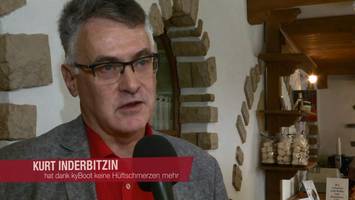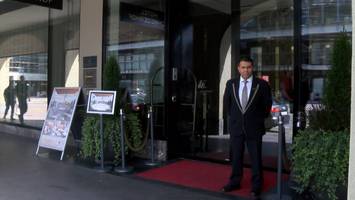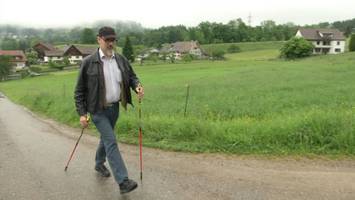Hip pain
With hip joint complaints, pain is felt most frequently in the area of the groin. However, hip joint complaints can also cause pain on the outside of the hip joint, the upper part of the thigh, the buttocks and sometimes in the knee.
Hip pain can be alleviated with kybun. Soft, elastic standing and walking dampens the impact from hard surfaces, strengthens the hip musculature and improves the posture.
Definition
Everyone means something different when they say ‘hip’. Some people only mean the joint itself. Others view the small of the back, pelvis and upper thigh as part of the hip.
By definition, the hip includes the hip joint and surrounding area from the waist to the upper part of the leg.
Hip pain may occur after severe physical strain but also at rest. It may express itself as pain when you get going in the morning, as pain that occurs in phases or as a chronic complaint. It is frequently accompanied by feelings of instability, stiffness and a limited range of motion.
A distinction is made between acute pain and chronic pain that has already lasted longer than three months.
Causes
There are numerous possible causes of hip pain. It is therefore important to define these complaints clearly.
A common case of hip pain: signs of wear (osteoarthritis) in the joint.
Hip pain is often equated with osteoarthritis pain in the hip. However, the main causes are usually found in the area of corresponding muscles, tendons, bursa and nerves. Sometimes there is also something wrong with the small of the back (lumbar spine), or the disturbance lies outside the locomotor system.
Other causes:
- Overloading due to training and work (e.g. tense hip musculature)
- Hip impingement (restriction of the hip joint)
- Accidents or joint injuries
- Congenital malpositions
- Osteoporosis
- Infections
- Chronic arthritis
- Metabolic disturbances (gout, rheumatism)
- Pressure on nerves (nerve root in the spine or locally on the hip joint)
Long-term consequences – trapped in a vicious circle
Hip pain can lead to relieving postures, which overload other joints and body structures and cause secondary disorders or secondary pain. Furthermore, pain leads to a reduction in exercise and those who move less automatically put on more weight. This in turn has a negative effect on hip complaints. Many affected by chronic (joint) pain are therefore caught in a downward spiral. The primary therapy objective is to escape this downward spiral.
Conventional therapy
Conservative treatment methods in case of hip pain primarily consist of weight loss if necessary, and of movement exercises, which are put together and taught by a physiotherapist. The aim of such exercises is to strengthen the muscles surrounding the joint and to improve hip mobility. Additional treatment approaches include massage, the application of heat and cold, pharmacology treatment and orthopaedic devices.
The objective of conservative therapy is to maintain joint function and reduce pain.
The kybun mat and kybun shoe are ideal for bringing more movement to everyday life and escaping the downward spiral of hip pain – all without spending any additional time. Acute pain is relieved quickly and longer walking distances are possible again since strain on the hip joints is reduced.
The soft, elastic foam material acts as a ‘crumple zone’, effectively dampening impact on the joints during running and walking.
Exercise becomes more comfortable again, and hip complaints are reduced after just a few minutes in most cases. Those who like to exercise frequently find it much easier to shed extra pounds, which in turn reduces strain on the joints. Nearly all customers affected by (joint) pain report a reduction in pain since they started wearing the kybun shoe.
It’s not only the cushioning effect that helps alleviate pain. When standing the soft, elastic supporting underlay, one automatically keeps moving very slightly. When standing and walking on soft, elastic materials, the core stability musculature has to make a major contribution in order to stabilise the joints. Strong core stabilising musculature ensures an upright posture, resulting in more precise movements in the joints. Lack of exercise due to pain results in long-term muscle loss (amyotrophia). Signs of excessive strain in the hip joint can develop more quickly as a result. The ability to stabilise the joints under load can be improved again through proprioceptive, sensorimotor and coordination training on an unstable surface. This also leads to a reduction in (joint) pain. Training the core stabilising musculature is easy to integrate into everyday life by wearing the kybun shoe.
Attention! Short-term effects are often confused with lasting effects.
The adjustment processes in the body triggered by the kybun shoe can take months or even years. Achieving lasting change is a protracted process.
Despite that, the effect of the soft, elastic material can also be felt quickly, for example in the relaxation of tense muscles and the alleviation of pressure points. These short-term effects must not be confused with the effects in the long run, since the long-term adjustment process cannot progress far enough in a week to be perceptible.
Short-term effects, on the other hand, can disappear again just as quickly as they came, or can even turn into complaints if you do not take the necessary breaks in the beginning.
Therefore, it is important to understand that an initial reaction and a reduction of the positive feeling in the first few weeks with the kybun shoe does not mean that the kybun shoe is no longer working, but merely that the short-term sense of well-being is declining!
Prevention with kybun
Everyone knows that the body is subject to wear, and that problems while walking and running are bound to occur sooner or later. Yet most people only start to consciously perceive their body as a fragile and transient structure once they experience problems. In most cases, however, it is already too late because irreversible damage such as cartilage wear has already occurred.
Therefore it is important to act before pain is felt or is increasing. The kybun mat and kybun shoe help protect the joints and prevent osteoarthritis even in youth.
Initial reactions
kybun exercises
For information about the special kybun shoe exercises or the basic kybun mat exercises, please click here: kybun exercises
The following adaptations to the standard implementation of interval walking are important in case of hip pain :
- Focus on fast exercises
- Slow exercises to allow you to recover in between. Be sure not to walk too slowly while performing the exercises, otherwise the muscles will tense up.
Application tips
- Upright body posture
- Do not make your steps too long
- Everyday/leisure: Walk with the kybun shoe or use the kybun mat as much as possible. Take note of fatigue > perform the kybun exercises regularly and take a short break if needed.
- Job: Sit as little as possible. Alternate sitting and standing in the beginning, and take along replacement shoes to change into
- If you feel unsafe/too unstable in the kybun shoe even after a test walk, we recommend a kybun shoe model with a lower rebound effect. These have a somewhat wider sole in the area of the midfoot, providing added stability. Seek advice from your local kybun expert.
- If you find the kybun shoe model with lower rebound effect too unstable for you as well, we recommend the kybun mat. You can choose the thickness you are comfortable with (the thicker, the less stable, the more intensive the training). You can also hold on to a fixed object. This can be helpful especially in the beginning after the operation, until you regain confidence in the hip.
- Precise movements are essential with hip pain. Pay attention to exact movements and take a break in case of fatigue or weakness. Lateral/medial rolling of the ankle joint on the soft, elastic material has to be corrected so that the load is applied to the foot, knee and hip with proper axial alignment. Read more under ‘Lateral/medial rolling of the ankle joint’.
- Contact a kybun dealer you trust if you have further questions, feel insecure or if there is no alleviation of pain when using the kybun shoe even though you are following the tips.
Opinions/customer testimonials
How did you find out about the World of walk-on-air? I came on a daytrip with the Chrischona church in Amriswil/Romanshorn/Arbon.
How does it feel to wear kybun shoes?
Fantastic, it’s like walking on clouds. It’s very pleasant.
Would you recommend the product to others?
Absolutely, I would definitely recommend it!
The real benefit for me is that I’m comfortable when walking and have a lightness to my step. I don’t have a limp despite two surgically repaired hips, and my feet don’t sweat and are never tired. My feet are moving, I feel good and I stand up straight. I no longer hunch over, and my back pain is gone. The kyBoot is everything I had hoped for from a custom shoe.
I had pain in my hips and kidneys. So I considered what I could do about it. I won’t go to the doctor, as he only prescribes me drugs. Then, it occurred to me that I already have shoes like these. I tried them out and within three days, the pain was gone. It really is true.
Anyone who would like to have that soft feeling when they walk, people who need to take care of their joints and anyone who has hip, knee or back problems. I highly recommend trying out these shoes.
I was able to get rid of my heel symptoms and, now, I can walk around with virtually no pain in my hip joints.
The benefit of the shoe is that it absorbs the impact incurred when walking around, which, in turn, relieves the hip and knee joints as well as the heels.
What was the best thing about the Production Experience tour? I liked everything about it really. Especially the treadmill and this piece of equipment, the SensoPro. It’s amazing. It’s the perfect way to train for skiing. How long have you been wearing kybun shoes? I had two hip operations. That was two or three years ago and I’ve been wearing kybun shoes ever since. I’m absolutely delighted with them. They are fantastic. I have six pairs. Would you recommend the Production Experience tour to others? Definitely! It really is something special. I also learned to be more mindful of how I walk. I had been neglecting it. I do it when I’m out Nordic walking but I hadn’t really thought about it when walking normally. I suppose I just lost the ability to do it. But it’s what I learned here today and it’s something I really value.
At 66 years old, I have had two hip replacements, a right knee replacement, and have undergone two major back operations. My knees had always been swollen, but once I tried the kybun shoe, they became normal again after two days. Now I can walk for hours without limping. I feel truly alive again.
I never would have thought this much was possible from a shoe alone. Who would have thought that you could improve your entire quality of life thanks to a shoe alone and not have to do anything other than just put on your shoes like everyone else and start walking. As I said, it comes close to a miracle for me.
I had serious problems. I had to wear orthopaedic insoles all the time for the last years. I used to have regular problems with my hips. That's all gone now. I no longer wear insoles and the hip pain has almost entirely gone.
I feel good in these shoes. I can walk and stand in them as long as I like. My hips don't hurt, my knees don't hurt. I simply feel fine. ![]() Watch the video
Watch the video





























